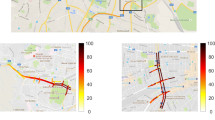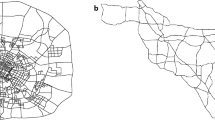Abstract
Round norms τl p, p ∈ (1,2] and block norms have been utilised for modelling actual distances in transportation networks. A geometric setting will permit the establishment of a relationship between bias of the road network distance and trajectory deviations, which will be used to separate the set of origin-destination pairs into two samples and also to analyse each sample using regression, thus obtaining several types of estimators. What will be demonstrated in this paper is that these functions can be combined through either a weighted sum, or by means of the introduction of the expected distance concept applied to the bias, to obain distance predicting functions for the region considered.
Similar content being viewed by others
References
Brimberg, J. and R.F. Love (1991). “Estimating Travel Distances by the Weightedl p Norm”.Naval Research Logistics 38, 241–259.
Brimberg, J. and R.F. Love (1992). “A New Distance Function for Modeling Travel Distances in a Transportation Network”.Transportation Science 26, 129–137.
Brimberg, J. and R.F. Love (1993a). “Directional Bias of thel p-Norm”.European Journal of Operational Research 67, 287–294.
Brimberg, J. and R.F. Love (1993b). “General Considerations on the Use of the Weightedl p Norm as an Empirical Distance Measure”.Transportation Science 27, 341–349.
Brimberg, J., P.D. Dowling and R.F. Love (1994). “The Weighted One-Two Norm Distance Model: Empirical Validation and Confidence Interval Estimation”.Location Science 2, 91–100.
Brimberg, J., P.D. Dowling and R.F. Love (1996). “Estimating the Parameters of the Weightedl p Norm by Linear Regression”.IIE Transactions 28, 363–367.
Love, R.F. and J.G. Morris (1988). “On Estimating Road Distances by Mathematical Functions”.European Journal of Operational Research 36, 251–253.
Love, R.F., J.G. Morris and G.O. Wesolowsky (1988). “Facilities Location: Models and Methods”.North-Holland, New York (EEUU).
Love, R.F. and J.H. Walker (1994). “An Empirical Comparison of Block and Round Norms for Modeling Actual Distances”.Location Science 2, 21–43.
Mesa, J.A. and F.A. Ortega (1996). “Determining Regular Networks for Each Givenl p Function (p ∈ [1,2])”.Studies in Locational Analysis 10, 91–108.
Muñoz, M. and J. Puerto (1996). “Problemas de Localización Estocástica Continua”.Lecturas en Teoría de Localización, 167–195. Universidad de Sevilla Sevilla (España).
Ortega, F.A. (1997). “Localización y Trazado de Redes”.Ph.D. Thesis, Universidad de Sevilla, Sevilla, Spain.
Widmayer, P., Y.F. Yu and C.K. Wong (1987). “On Some Distance Problems in Fixed Orientations”.SIAM J. Comput. 16, 728–746.
Author information
Authors and Affiliations
Corresponding author
Rights and permissions
About this article
Cite this article
Ortega, F.A., Mesa, J.A. A methodology for modelling travel distances by Bias estimation. Top 6, 287–311 (1998). https://doi.org/10.1007/BF02564793
Received:
Accepted:
Issue Date:
DOI: https://doi.org/10.1007/BF02564793




